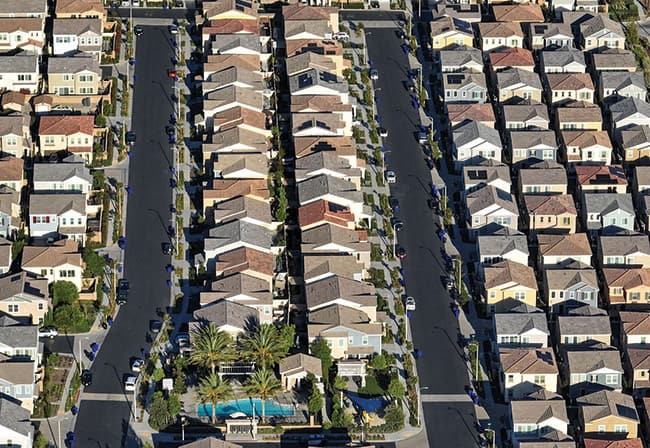City sued over noncompliance with state housing element law

Claremont is one of nine cities sued for not complying with state housing element law. Three of those cities have since settled their lawsuits. COURIER photo/Peter Weinberger
by Steven Felschundneff | steven@claremont-courier.com
Californians for Homeownership, a nonprofit that aims to combat California’s “housing access and affordability crisis,” has sued the City of Claremont to compel it to comply with the State of California’s housing element law.
Claremont was one of three cities, the others being Fullerton and La Mirada, targeted by the nonprofit in lawsuits filed Friday, September 16. In total, the organization has sued nine Southern California cities, three of which — Bradbury, Laguna Hills, and South Pasadena — have settled their suits by providing additional resources demonstrating progress in compliance.
In an email on Tuesday, Matthew Gelfand, an attorney with Californians for Homeownership, said Claremont, Fullerton and La Mirada were singled out because “in our assessment, they are unlikely to adopt valid housing elements within the next six to 12 months without being forced to do so through litigation.”
Californians for Homeownership is an independent 501(c)(3) organization that was formed by and receives its primary financial and operational support from the California Association of Realtors.
“All three cities have been told by state regulators that they must make significant changes to their draft housing elements before they can be adopted and certified by the state. But unlike many of their peers in the region, these cities have made little progress in doing so,” according to Gelfand.
A news release from Claremont’s Public Information Officer Bevin Handel contradicts that assessment, noting that the city is in the midst of updating its sixth cycle of the housing element after submitting a draft document to the California Department of Housing and Community Development in December 2021. According to the release, the city received a 15-page review letter from HCD on February 7, 2022, with specific recommendations, and is nearly ready to submit an update.
The city has engaged with Claremont residents through multiple community meetings over the last two years, including a public review of the draft housing element in December 2021, according to Handel.
At issue are California’s Regional Housing Needs Allocation laws, which involve state and local governments working together to identify the number of units needed in a region for California to reach its housing goals. The Southern California Association of Governments takes the lead in the Regional Housing Needs Allocations in the Southland, including deciding how many residential units each city must anticipate.
“In March 2020, SCAG adopted its 6th cycle RHNA allocation plan, which covers the planning period October 2021 through October 2029. For the 6th cycle, SCAG received a need of 1,341,827 housing units, which was distributed to all 197 SCAG jurisdictions,” according to a release from the Southern California Association of Governments.
Each city incorporates its portion of the RHNA requirement into its housing element update, which is part of its general plan, and must identify adequate sites for housing developments, including units for low and very low-income families. While the deadline for submitting the updated housing element was October 2021, the state gave municipalities more time to complete the process.
“The Housing Element is part of the City’s General Plan and contains a demographic profile of the City, an analysis of affordable housing opportunities and constraints, an evaluation of existing housing programs, as well as goals, policies, and implementation programs,” according to the City of Claremont’s website. “The Housing Element Update will identify potential sites in Claremont to meet the State’s requirement of 1,707 new housing units,”
The news release from Handel notes that according to HCD data, among 539 municipalities, Claremont is one of 201 that are out of compliance because it has not updated the housing element.
Explaining the lawsuit, Gelfand said Claremont has made no meaningful progress toward revising its housing element since receiving the guidance from HCD in February and has not responded to letters from Californians for Homeownership demanding compliance and offering a pre-litigation compromise.
“So, while it is true that other jurisdictions in Southern California are behind in adopting final versions of their housing elements, Claremont is an extreme outlier in its lack of progress and its refusal to engage with us on this issue,” Gelfand said.
“Claremont is committed to complying with the State’s Housing Element law,” read the press release from Handel. “It is working diligently to prepare a draft of its sixth cycle Housing Element update. The City expects to complete a draft Housing Element update addressing the comments received from the HCD within the next 30 days.”
“Like most cities in the San Gabriel Valley, the City of Claremont is using special housing consultants to assist in the completion of its Housing Element update,” said Claremont Community Development Director Brad Johnson in the press release. “For a variety of reasons, these consultants are experiencing very high demand, which has resulted in slower than anticipated progress on Claremont’s Housing Element update.”
The city has contracted with Houseal Lavigne to take the recommendations from the state and incorporate them into the draft housing element.
On Wednesday, September 21, Johnson told the COURIER in an email that the second version of the draft housing element update will be a submitted back to the Department of Housing and Community Development within 30 days. The state will take 60 days to review and comment on this second revised version of the element.
“We are not 30 days away from certification of the housing element,” Johnson wrote. “Once HCD accepts our draft element as being in compliance with state housing element law, the city will begin the adoption process through the public hearing processes of the planning commission and city council. This will include neighborhood notifications and outreach for public participation at the public hearings.”









0 Comments